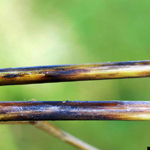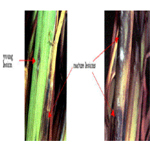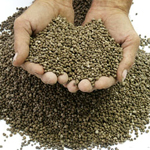|
Stem Rot
(Sclerotium oryzae)
| Symptoms |
|
| |
|
- Initial symptoms are small, irregular black lesions on the outer leaf sheath near water level
- Lesions expand as the disease advances
- Infected stem rots
- Visible numerous tiny white and black sclerotia and mycelium inside the infected culms
- Infected culm lodges and caused unfilled panicles and chalky grain
- Severe infection causes tiller death
- The disease aggravates the plants to lodge
|
 |
 |
| Stem Rot |
Stem Rot |
|
| Top |
| |
Identification of pathogen |
|
|
 |
 |
- The perithecia are dark, globose, and embedded in outer tissues of the sheath.
- The asci are narrowly clavate with almost invisible walls and deliquescing by the time the spores mature.
- The sclerotia are black and globose or near globose and smooth
- The conidiophores are dark, upright, and septate.
- Conidia are fusiform, three-septate, curved, and are produced on pointed sterigmata.
|
| Sclerotium Oryzae |
Sclerotium Oryzae |
|
| Top |
| Management Strategies |
|
|
|
- Burning straw and stubble or any crop residue after harvest or letting the straw decompose and draining the field can reduce sclerotia in the field.
- A balanced use of fertilizer or split application with high potash and lime to increase soil pH reduces stem rot infection and increases yield.
- Chemicals such as fentin hydroxide sprayed at the mid-tillering stage, thiophanate-methyl sprayed at the time of disease initiation can reduce stem rot incidence in the rice field.
- The use of other fungicides such as Ferimzone and validamycin A also effective against the fungus.
|
 |
 |
| Fentin Hydroxide |
Lime Fertilizer |
| Top |
|






